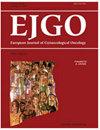卵巢恶性无生殖细胞瘤的治疗
IF 0.5
4区 医学
Q4 OBSTETRICS & GYNECOLOGY
引用次数: 3
摘要
恶性卵巢生殖细胞肿瘤的治疗进展是妇科肿瘤学史上最成功的进展之一,其中生殖异常瘤是最常见的恶性卵巢生殖细胞肿瘤类型。自20世纪80年代引入铂类化疗以来,早期生殖细胞异常瘤的5年生存率已接近100%,晚期则高达98%。尽管取得了这一显著成就,但在常规治疗中仍存在许多问题。通过进行文献回顾,我们的目的是强调目前恶性生殖异常瘤的治疗和未解决的问题,在现代管理的这种疾病。这些问题首先与手术治疗有关,如常规网膜切除术和淋巴结切除术的作用,完全手术切除的价值,以及保留生育能力的手术的可能性。其次,将讨论化疗和早期降糖的可能性问题以及晚期新辅助化疗的潜力。最后,简要概述了目前新的药物治疗方案的发展。本文章由计算机程序翻译,如有差异,请以英文原文为准。
Management of malignant dysgerminoma of the ovary
The evolution of treatment for malignant ovarian germ cell tumors has been one of the most successful in the history of gynecologic oncology, with dysgerminoma as the most common type of malignant ovarian germ cell tumors. Since the introduction of platinum-based chemotherapy in the 1980s, 5-year survival rates for early-stage dysgerminomas have been close to 100%, and as high as 98% for advanced stages. Despite this remarkable achievement, many questions remain in routine treatment. By performing a literature review, we aim to highlight both the current treatment of malignant dysgerminoma and unanswered questions in the modern management of this disease. These issues relate firstly to surgical therapy, such as the role of routine omentectomy and lymphadenectomy, the value of complete surgical resection, and the possibility of fertility-sparing surgery. Second, chemotherapy and the question of the possibility of de-escalation in early stages and the potential of neoadjuvant chemotherapy in advanced stages will be addressed. Finally, a brief overview of the current developments of new drug treatment regimens will be given.
求助全文
通过发布文献求助,成功后即可免费获取论文全文。
去求助
来源期刊
自引率
25.00%
发文量
58
审稿时长
1 months
期刊介绍:
EJGO is dedicated to publishing editorial articles in the Distinguished Expert Series and original research papers, case reports, letters to the Editor, book reviews, and newsletters. The Journal was founded in 1980 the second gynaecologic oncology hyperspecialization Journal in the world. Its aim is the diffusion of scientific, clinical and practical progress, and knowledge in female neoplastic diseases in an interdisciplinary approach among gynaecologists, oncologists, radiotherapists, surgeons, chemotherapists, pathologists, epidemiologists, and so on.

 求助内容:
求助内容: 应助结果提醒方式:
应助结果提醒方式:


